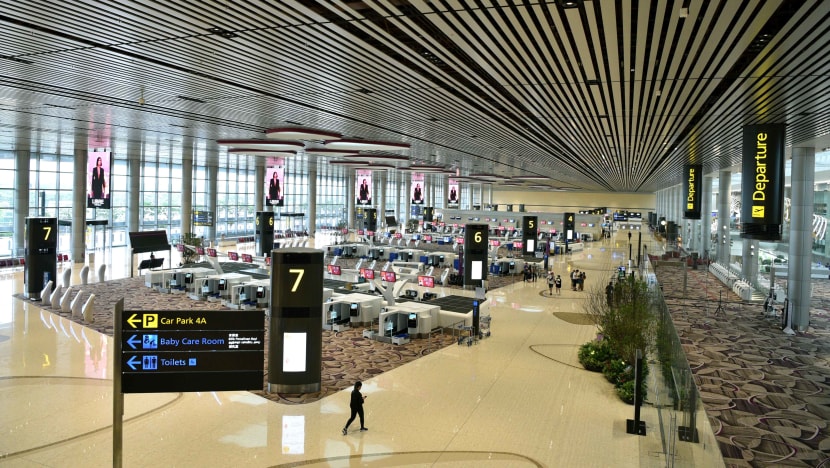Use of Changi Airport Terminal 4 to process travellers from 'very high-risk' COVID-19 regions being studied

Operations at Changi Airport Terminal 4 have been suspended since May 2020 because of the COVID-19 pandemic. (Photo: Jeremy Long)
SINGAPORE: Authorities are considering using Changi Airport Terminal 4 to process passengers from regions with a “very high risk” of COVID-19, said Minister for Transport S Iswaran on Tuesday (Jul 6).
Speaking in Parliament, Mr Iswaran noted these passengers are currently being processed at dedicated bus gates at Terminal 2 before being transported directly to dedicated facilities to serve out their stay-home notice. He added that transfer passengers from such high-risk regions are not allowed.
Operations at Terminal 2 were suspended in April last year to allow for upgrading works, and Terminal 4 followed suit a month later due to the steep decline in air travel caused by the COVID-19 pandemic.
“What MOT (Ministry of Transport), CAAS (Civil Aviation Authority of Singapore) and Changi Airport Group did was to work together and come up with the idea of remote processing remote bays, as it were, for passengers from very high-risk countries,” said Mr Iswaran.
These passengers go through immigration, COVID-19 testing and other processes in such bays at Terminal 2, and are then immediately taken in buses to stay-home notice facilities, said Mr Iswaran.
These buses - which are used only to ferry travellers to stay-home notice facilities and do not carry other passengers - are cleaned and disinfected after every trip, said Mr Iswaran.
READ: Timeline: How Changi Airport became Singapore's largest active cluster
PPE FOR BUS DRIVERS
Drivers of these buses - who are fully vaccinated and subject to regular COVID-19 testing - wear personal protective equipment (PPE) including N95 masks, PPE gowns and gloves, he added.
In addition, travellers occupy only the rear section of the vehicle and are not allowed to sit near the driver, with the number of passengers allowed on each bus limited to less than half its total capacity to ensure adequate safe distancing.
On the use of Terminal 4 to process passengers from high-risk regions, Mr Iswaran said this would enhance the airport’s ability to deal with the flow of passengers from such regions.
“We are studying the use of T4 for this purpose because T4 will have larger capacity, and it is something that now the various agencies involved are working through,” he said.
Mr Iswaran was responding to questions from various Members of Parliament - including Mr Dennis Tan (WP-Hougang) and Mr Saktiandi Supaat (PAP-Bishan-Toa Payoh), who had asked whether dedicated facilities could be established away from the main arrival terminals to process passengers from high-risk regions.
READ: Commentary: Targeted travel restrictions needed but careful not to undermine Changi Airport's connectivity
MEASURES REVIEWED REGULARLY
Mr Iswaran said measures aimed at protecting airport workers and members of the public from the risk of COVID-19 transmission are reviewed regularly in line with public health experts’ latest understanding of the virus, as well as the evolving coronavirus situation around the world.
He gave the example of how mandatory on-arrival COVID-19 tests, introduced in January this year, were conducted at separate health screening stations for passengers from very high-risk places.
Such measures helped keep borders open and allow the airport to serve more than six million arriving passengers between January 2020 and May this year, he noted.
However, the Delta variant of COVID-19 “breached these defences” in May this year, resulting in the first airport cluster, said Mr Iswaran.
Measures were tightened in consultation with the Health Ministry and the National Centre for Infectious Diseases (NCID), he said.
“Beyond the earlier passenger segregation measures, the airport itself is now segregated into physical zones. Disembarkation piers, toilets, arrival immigration halls, and baggage claim belts, are now separate for passengers from places of different risk,” he said.
READ: S$15 million support to help Changi Airport workers adjust to enhanced COVID-19 safety measures
Responding to Mr Leon Perera (WP-Aljunied) on whether there had been intermingling between passengers from regions with different risk assessments prior to the introduction of these measures, Mr Iswaran said: “There may well have been some intermingling, but that was not something that was encouraged.”
“It was actually generally designed for people to move from the aircraft to the immigration process, collect their baggage and exit,” he said.
The current physical segregation is “turning the (airport’s) operating model on its head”, he said.
The authorities want to do everything possible to ensure the safety of air passengers, aviation workers and their families, as well as the greater community, Mr Iswaran stressed.
“But we also want to ensure that the measures we take reflect our best judgment of the risks based on an evolving situation, and we ensure - to the best of our ability - that we respond in a manner that addresses those risks.”
BOOKMARK THIS: Our comprehensive coverage of the COVID-19 pandemic and its developments
Download our app or subscribe to our Telegram channel for the latest updates on the coronavirus outbreak: https://cna.asia/telegram












